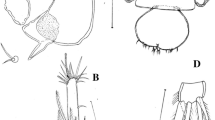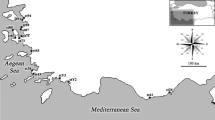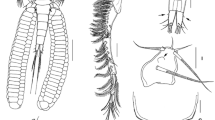Abstract
In the present study, we contribute to the diversity of marine meiofauna of Turkey by describing both sexes of Schizopera karanovici sp. nov., which were collected from the intertidal zone of Alata beach, Turkey. The new species is closely related to S. lagrecai Pesce 1988, S. minuta Noodt 1955, and S. variseta Bozic, 1964, but can easily be differentiated from its congeners by the width/length ratio and setal organisation of the caudal rami and P5.
Similar content being viewed by others
Avoid common mistakes on your manuscript.
Introduction
Schizopera Sars, 1905 is the most species-rich genus within the family Miraciidae Dana, 1846, with a world-wide distribution comprising 96 valid species and subspecies (Karanovic and McRae 2013). Members of the genus are predominantly marine and benthic, but they also inhabit brackish water and a wide spectrum of freshwater habitats. The genus has been a subject of taxonomic debate since its establishment by Sars (1905), and has undergone various changes. Briefly, Apostolov (1982) divided Schizopera into three genera and all three genera into two subgenera, namely Schizopera (Schizopera s. str. and Neoschizopera), Eoschizopera (Eoschizopera s. str. and Praeoschizopera), and Schizoperopsis (Schizoperopsis s. str. and Psammoschizoperopsis), based on the segmentation of the first and fourth swimming legs. Subsequently, these generic and subgeneric divisions were rejected by Mielke (1995), who considered them as artificial groups of species that were based on symplesiomorphies. Karanovic and Ranga Reddy (2004) also revised the genus and rejected the groupings that had been established by Apostolov (1982), but maintained Eoschizopera as a valid genus.
During the re-examination of miraciid specimens collected from numerous localities along the Turkish Coasts, a new species of Schizopera was identified and is described herein. This is the fourth representative of this genus from Turkey and the only endemic one. The three previously known species, namely S. brusinae Petkovski, 1954, S. gligici Petkovski, 1957 and S. pratensis Noodt, 1958, have somewhat wider Mediterranean distributions (Sönmez et al. 2014).
Material and methods
Samples were collected from Alata Beach / Mersin using the Karaman-Chappuis method (Delamare Deboutteville 1954) on four different dates. Prior to dissection, the habitus was drawn from whole specimens that were temporarily mounted in lactophenol. Specimens were dissected in lactic acid, and the dissected parts were mounted in lactophenol mounting medium under an Olympus SZX-12 stereo microscope and prepared for observation and drawing as described in Sak et al. (2008). Drawings were made with the help of a camera lucida on an Olympus BX-50 and BX-51 differential interference contrast microscope. Total body length was measured from the anterior margin of the rostrum to the posterior margin of the caudal rami. Measurements were made with an ocular micrometre. Specimens were examined with a Zeiss SUPRA 55VP (FESEM) scanning electron microscope in the Mersin University Advanced Technology Education, Research and Application Center (MEITAM). Specimens for SEM observation were prepared as described in Kaymak and Karaytuğ (2014). The descriptive terminology is adopted from Huys et al. (1996). Abbreviations used in the text are: ae, aesthetasc; P1–P6, for swimming legs 1–6; and exp (enp)-1 (−2, −3) to denote the proximal (middle, distal) segment of a ramus. Material was deposited in the Zoology Museum of Adıyaman University (ZMADYU) and in the collection of Mersin University Biology Department.
Results
Family Miraciidae Dana, 1846
Genus Schizopera
Schizopera karanovici sp. nov.
Type locality
Turkey, Mediterranean coast, Mersin Province; intertidal zone of Alata beach (N 36o 37 766′; E 34o 20 917′),
Material examined
Holotype: female (ZMADYU2008/87), stored in ethanol; allotype: (ZMADYU2008/88) dissected on five slides; paratypes: one male (ZMADYU2008/89) dissected on seven slides, collected on 20 February 2008; one female collected on 27 May 2007; one male collected on 28 December 2007; one female and three males collected on 26 July 2007; one female and three males collected on 20 February 2008; 28 females and 23 males (deposited in the collection of Mersin University biology department). Leg. S. Karaytuğ.
Description (based on female paratypes)
Total body length from tip of the rostrum to the posterior margin of the caudal rami: 486 μm (mean = 486 μm; max = 545; min = 423; n = 10). Body cylindrical, slightly tapering slightly posteriorly. Sensillar pattern and spinular ornamentation of somites as figured (Fig. 1a, b). Rostrum triangular and elongate, reaching half of the second antennular segment, with 2 min sensillae, defined at base (Fig. 1a, b). Genital double somite wider than long in dorsal view; bears a row of tiny spinules and eight sensillae dorsally (Fig. 1b), ventral surface with two sensillae near posterior margin (Fig. 6a). Genital field as figured (Fig. 6a). Free abdominal somites with rows of spinules dorsally and ventrally (Figs. 1b, 6a). Third abdominal somite with pseudooperculum. Anal somite with rows of minute spinules near anal operculum as figured (Fig. 6a).
Caudal rami (Figs. 2c, d, 6a) about twice as long as wide in dorsal view; bears long and fine spinules at inner margin, a tube pore located on ventral surface near posterior margin and row of spinules on the dorsal and ventral surfaces of posterior margin, with six setae: seta I absent; seta II and seta III plumose; seta IV and V well developed, with a fracture plane at base; seta VI thin, short and naked; seta VII located on dorsal surface, plumose and tri-articulated at base.
Antennule (Figs. 2a, 4a, b) eight-segmented; all setae naked except the one plumose seta in segment two; segment two longest, about 1.75 times longer than wide; segment four bears a long aesthetasc fused basally to a seta; segment eight bears an apical acrothek consisting of a short aesthetasc and two setae. Armature formula: 1-[1], 2-[8], 3-[6], 4[2+(1+ae)], 5[2], 6[5], 7[4], 8[6+acrothek]
Antenna (Figs. 2b, 4d) coxa small and naked. Allobasis long with a row of spinule near the base of exopod and outer margin, abexopodal seta unipinnate. Exopod two-segmented; segment one longer than wide, with a unipinnate seta at distal corner; segment two longer than wide, inner and outer margins naked, with one naked and one plumose seta terminally and a spinule row at terminal margin. Free endopod two with rows of coarse spinules on lateral margin and finer spinules at inner distal corner; lateral armature consisting of four short spinulose spines; apical armature consisting of four long geniculate setae, one relatively short unipinnate seta and two naked setae fused at base.
Labrum (Fig. 3b) large and trapezoidal, ornamented with spinular rows as figured.
Mandible (Fig. 3c). Gnathobase elongated, cutting edge with several teeth distally and bears a short unipinnate seta at distal corner. Palp biramous with elongated basis. Basis with a short spinular row and three unipinnate setae. Exopod very small and squarish, bears two long and bare setae. Endopod elongated with two bare setae medially, two bare setae fused at base at inner distal, and three bare seta fused at base at outer distal (Fig. 4e).
Maxillule (Fig. 3d). Praecoxal arthrite with two short bare setae on anterior surface and nine elements on distal margin (see insertion in Fig. 3d). Coxal endit with one thick and curved unipinnate spine and one bare seta. Basis elongated and biramous, bears five bare setae, a bipinnate spine and a unipinnate claw like spine apically. Exopod very small with two bare setae. Endopod small and slightly elongated with four bare setae.
Maxilla (Fig. 3e). Syncoxa with three endites; proximal endite with three naked setae, middle endite with two bare setae, distal endite with a bare and two bipinnate setae. Allobasis prolonged to a unipinnate claw and armatured with a bare seta and a unipinnate spine. Endopod unisegmented, bears a bipinnate seta medially and four bare setae apically.
Maxilliped (Fig. 3f) subchelate with syncoxa, basis and uni-segmented endopod. Syncoxa ornamented with short spinular row as figured, bears two unipinnate and a bipinnate setae. Basis elongated, about 3.3 times as long as wide on anterior surface, ornamented with spinular rows as figured, and bears two bare setae. Endopod prolonged to a well-developed, claw-like unipinnate spine defined at base and accessorised with three short bare setae.
P1 (Fig. 5a) Intercoxal sclerite without ornamentation. Praecoxa a row of fine spinules on anterior surface. Coxa with spinuler rows on anterior surface as figured. Basis much narrower than coxa, anterior surface with secretory pore near the base of outer spine and various spinular rows as figured; outer and inner spines bipinnate, inner spine located midway along the inner margin. Rami 3-segmented. Exopod segments ornamented with a course row of spinules at outer margin. Exp-1 with a row of fine spinules on anterior surface near segment base, bears a well-developed bipinnate spine at outer distal corner, inner margin naked; exp-2 bears a well-developed bipinnate spine at outer distal corner, inner margin with fine spinules; exp-3 bears two geniculate and unipinnate setae at terminally and two short unipinnate spines at outer distal corner, inner margin naked. Endopod much longer than exopod; enp-1 as long as exopod, with a spinular row at outer and inner margin and bears a unipinnate seta near outer distal corner; enp-2 short, ornamented with fine spinules at inner and outer margin; enp-3 short, with 1 min seta at inner distal corner, one strong geniculate seta and one well-developed naked seta at terminal, ornamented with a fine row of spinule at outer corner.
P2-P4 (Fig. 5b–d) with three-segmented endopod and exopod. Coxa with spinular rows as figured. Basis with outer bipinnate spine (P2, P4) or a naked seta (P3). Exopod and endopod segments with coarse spinules at outer margin. Enp-1 without inner seta (P2) or a long serrate seta (P3, P4). Enp-2 bears one long unipinnate (P2) or serrate seta (P3, P4) at inner margin. Enp-3 bears four (P2), three (P3) or two setae (P4). Exp-1 inner margin naked. Exp-2 with one naked (P2) or unipinnate seta (P3, P4) at inner margin. Exp-3 with two long and two relatively short setae. Spine and seta formula as follows:
Endopod | Eksopod | |||||
P1 | 1 | 0 | 120 | 0 | 0 | 022 |
P2 | 0 | 1 | 121 | 0 | 1 | 022 |
P3 | 1 | 1 | 120 | 0 | 1 | 022 |
P4 | 1 | 1 | 020 | 0 | 1 | 022 |
P5 (Fig. 3a) biramous. Baseoendopod with one long and naked outer basal seta. Endopodal lob extends almost to the end of exopod, inner and outer margin unornamented, bears one pore at anterior surface, two bipinnate and two plumose setae. Exopod squarish, inner and outer margin unornamented, bears a tube pore on anterior surface, with four plumose and two bare setae.
P6 baseoendopod and exopod reduced to a short and wide plate, bears one closely set plumose and one bare seta (Fig. 3g).
Male (based on allotype)
Total body length from tip of the rostrum to the posterior margin of the caudal rami 410 μm (mean = 385 μm; max = 415; min = 327; n = 12) (Fig. 1c). Sexual dimorphism in antennule, P2 endopod, P3 exopod distal segment, P5, P6 and caudal rami.
Antennule (Fig. 2e) haplocer and ten segmented, all setae naked. Segment four very small with a minute bare seta; segment five with a lobate expansion anteriorly; bears a large aesthetasc arising from pedestal and fused basally to a long seta. Segment ten with an acrothek consisting of a short aesthetasc fused basally to two short setae. Armature formula: 1-[1], 2-[9], 3-[7], 4-[1], 5-[6+(1+ae)], 6-[1], 7-[0], 8-[1], 9-[4], 10-[5+acrothek].
P2 endopod (Fig. 6c) segment two derived from second and third endopodal segments of female; with one unipinnate seta at inner margin, one naked seta with forked tip near distal margin on anterior surface, inner distal corner with one long bipinnate seta and two sword-like long and broad spines distally.
P3 exopod distal segment (Fig. 5e) bears a hyaline spine on anterior surface in addition to the normal pattern of female.
P5 (Fig. 6b) medially fused, baseoendopod and exopod distinct. Endopodal lobe with two strong bipinnate spine terminally and one pore at anterior surface. Exopod with two strong bipinnate spines, one long plumose seta and two short naked setae.
P6 (Fig. 6b) medially fused to an asymmetrical plate. Each plate with one short bare spine at outer distal.
Caudal rami (Fig. 6b) about 1.5 times longer than wide, armature as in female.
Variability
Only observed in female P5 endopod: it can be armatured with three (Fig. 6a) or four setae (Fig. 3a). Abnormality (endopod with three setae) can be symmetric or asymmetric. Three paratype females were with three setae on the left side and with four setae on the right side, while one paratype female was abnormal on the both sides.
Etymology
The new species is named in honour of Dr. Tomislav Karanovic, in recognition of his significant contributions to the taxonomy of Harpacticoida.
Discussion
The new species described herein undoubtedly belongs to the genus Schizopera, owing to the presence of a hyaline bract on the male exp-3 and the two-segmented antennary exopod.
Within the 96 valid species of the genus, Schizopera karanovici sp. nov. is closely related to S. minuta, S. lagrecai and S. variseta, which have the same armature on P1-P5, but it can be differentiated from its congeners by various characters that are explained below. The most notable character is the shape of the caudal rami seta II of the female, which is filiform, short, very thin and naked in S. karanovici sp. nov., conspicuously bulbiform in S. minuta, an elongate spine in S. lagrecai and spiniform in S. variseta. Also, the length/width ratio of the caudal rami, which is 2.5 for S. minuta, 1.7 for S. lagrecai, 1 for S. variseta and 2 for S. karanovici sp. nov., can be used to distinguish these four species easily without dissection. According to Karanovic and Cooper (2012), these differences in the caudal rami shape are very significant in the differentiation of harpacticoid species, as they are used for species recognition by the male before copulation takes place. As an additional small difference that is hard to observe without dissection between the species mentioned above, except for S. lagrecai (a brackish-water species described by Pesce (1988) from the ground waters of Sicily, Italy), is the length/width ratio of the female P5 exopod. In S. karanovici and S. lagrecai, the P5 exopod is elongate and about 1.5 times as long as it is broad, while it is twice as long as it is broad in S. minuta, and very short and broad in S. variseta.
References
Apostolov A (1982) Genres et sous-genres nouveaux de la famille Diosaccidae Sars et Cylindropsyllidae Sars, Lang (Copepoda, Harpacticoidea). Acta Zool Bulg 19:37–42
Delamare Deboutteville C (1954) Recherches sur l’écologie et la répartition du mystacocaride Derocheilocaris remanei Delamare et Chappuis, en Méditerranée. Vie Milieu:321–380
Huys R, Gee JM, Moore CG, Hamond R (1996) Marine and brackish water harpacticoid copepods part 1: keys and notes for identification of the species. Synopses of the British Fauna (New series). Acedemic Press for the Linnean Society of London, London
Karanovic T, Cooper SJB (2012) Explosive radiation of the genus Schizopera Sars (Copepoda: Harpacticoida) in a small subterranean island in Western Australia: unravelling the cases of cryptic speciation, size differentiation, and multiple invasions. Invertebr Syst 26:115–192
Karanovic T, McRae J (2013) The genus Schizopera (Copepoda, Harpacticoida) in the Pilbara region of Western Australia, with description of a new species and its molecular and morphological affinities Records Of The Western Australian Museum 119:28
Karanovic T, Ranga Reddy Y (2004) A new genus and species of the family Diosaccidae (Copepoda: Harpacticoida) from the groundwaters of india. J Crustac Biol 24:246–260
Kaymak N, Karaytuğ S (2014) Systematics of the genus Heterolaophonte (Crustacea, Copepoda, Harpacticoida), with redescription of H. uncinata and H. curvata 2014 3780:31 doi:10.11646/zootaxa.3780.3.4
Mielke W (1995) Species of the taxon Schizopera (Copepoda) from the Pacific coast of Costa Rica Microfauna Marina 10:89–116
Pesce GL (1988) A new species of Schizopera Sars 1905 from groundwaters of Sicily. Italy Senckenb Biol 68:413–417
Sak S, Karaytuğ S, Huys R (2008) Ciplakastacus gen. nov. a primitive genus of Leptastacidae (Copepoda, Harpacticoida) from the Mediterranean coast of Turkey. J Nat Hist 42:2443–2459
Sars GO (1905) An account of the Crustacea of Norway: with short descriptions and figures of all the species. Bergen Museum, Bergen
Sönmez S, Sak S, Karaytuğ S (2014) Marine Interstitial and Phytal Miraciidae Dana, 1846 (Crustacea: Copepoda: Harpacticoida) Inhabiting along the Mediolittoral Zone of Turkish Coasts. J Anatol Nat Sci 5:52–87
Acknowledgments
We would like to thank David Ventham for reading the manuscript.
Author information
Authors and Affiliations
Corresponding author
Rights and permissions
About this article
Cite this article
Sönmez, S., Sak, S. & Karaytuğ, S. A new species of the genus Schizopera Sars, 1905 (Copepoda: Harpacticoida: Miraciidae) from the Mediterranean coast of Turkey. Mar Biodiv 45, 413–418 (2015). https://doi.org/10.1007/s12526-014-0307-3
Received:
Revised:
Accepted:
Published:
Issue Date:
DOI: https://doi.org/10.1007/s12526-014-0307-3










